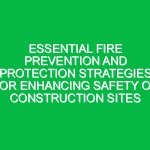Construction sites are bustling with activity, machinery, and potential hazards. Ensuring the safety and well-being of construction workers is paramount, which is where Personal Protective Equipment (PPE) comes into play. This essential guide is designed to provide comprehensive insights into the PPE necessary for construction workers, aiming to enhance safety on site. Whether you’re a seasoned professional or new to the construction industry, understanding the significance of PPE is crucial in fostering a safe working environment.
Understanding the Importance of PPE in Construction
Personal Protective Equipment (PPE) is more than just gear; it’s a critical component of the Health Safety and Environment (HSE) domain, designed to protect workers from injury or illness resulting from contact with chemical, radiological, physical, electrical, mechanical, or other workplace hazards. In the construction industry, where the risk of accidents and injuries is high, PPE serves as the first line of defense for workers.
The Role of PPE in Preventing Workplace Injuries
PPE plays a pivotal role in minimizing exposure to hazards that cause serious workplace injuries and illnesses. It includes items such as gloves, safety glasses, earplugs, hard hats, safety shoes, respirators, or coveralls. These items are designed to protect workers from specific hazards identified during a risk assessment process. By wearing PPE, construction workers can significantly reduce their risk of injury on site.
Key Components of PPE for Construction Workers
To ensure comprehensive protection, it’s essential to understand the different components of PPE and their specific uses in the construction industry. Here’s a breakdown of the key pieces of PPE every construction worker should be familiar with:
Head Protection: Hard Hats
Hard hats are the hallmark of construction site safety. They protect against falling objects, bumps to the head, and electrical hazards. It’s important to choose hard hats that meet industry standards for maximum protection.
Eye and Face Protection: Safety Glasses and Face Shields
Construction sites are rife with flying debris, dust, and chemical splashes. Safety glasses and face shields protect against these hazards, preventing eye injuries and ensuring workers maintain clear vision on the job.
Hearing Protection: Earplugs and Earmuffs
Loud machinery and equipment can pose significant risks to hearing over time. Earplugs and earmuffs are essential in environments with high noise levels, protecting workers from hearing loss.
Respiratory Protection: Masks and Respirators
Inhalation of dust, fumes, and vapors can lead to respiratory issues. Masks and respirators are crucial in environments where air quality is compromised, filtering out harmful particles and ensuring clean breathing air.
Hand and Skin Protection: Gloves and Protective Clothing
From cuts and abrasions to exposure to harmful substances, the hands and skin are vulnerable on construction sites. Gloves and protective clothing shield against these risks, tailored to the specific job and materials handled.
Foot Protection: Safety Boots
Safety boots are essential for protecting feet from heavy falling objects, punctures, and slips. They should have a steel toe cap and slip-resistant soles for maximum protection.
Best Practices for PPE Use in Construction
Merely having access to PPE is not enough. It’s crucial to adhere to best practices to ensure the equipment provides the intended protection. Here are some guidelines to follow:
Proper Selection and Fit
Choose PPE that is suitable for the specific hazards of the job and ensure it fits the wearer correctly. Ill-fitting PPE can compromise its effectiveness and lead to discomfort or additional hazards.
Regular Maintenance and Inspection
PPE should be regularly inspected for wear and tear and maintained according to the manufacturer’s instructions. Damaged or defective PPE should be replaced immediately.
Training and Awareness
Workers should be trained on the correct use, limitations, and care of their PPE. Awareness of how to properly wear, adjust, and maintain PPE is essential for its effectiveness.
Conclusion: Enhancing Safety on Construction Sites
Personal Protective Equipment (PPE) is an indispensable part of ensuring safety on construction sites. By understanding the various components of PPE and adhering to best practices for its use, construction workers can significantly reduce their risk of injury and create a safer working environment. Remember, safety starts with awareness and is maintained through diligence and proper use of protective gear. Let’s commit to enhancing safety on site by prioritizing the use of PPE and fostering a culture of safety within the construction industry.
Summary of Key Points
- PPE is essential for protecting construction workers from various workplace hazards.
- Key components of PPE include head, eye and face, hearing, respiratory, hand and skin, and foot protection.
- Best practices for PPE use involve proper selection and fit, regular maintenance and inspection, and comprehensive training and awareness.
- By prioritizing the use of PPE, construction workers can enhance safety on site and reduce the risk of injury.


